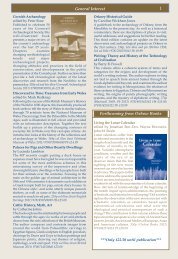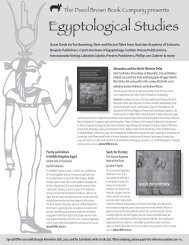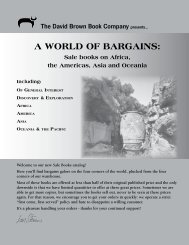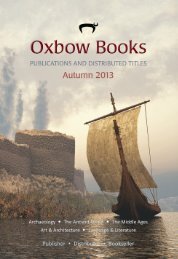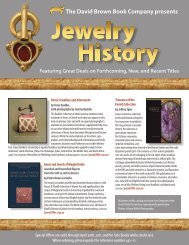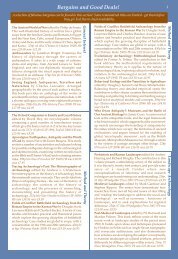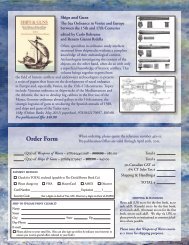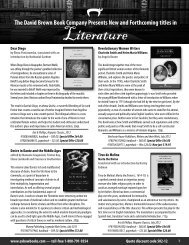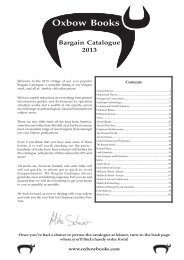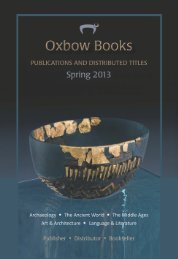New Distributed Titles Fall 2009 - Oxbow Books
New Distributed Titles Fall 2009 - Oxbow Books
New Distributed Titles Fall 2009 - Oxbow Books
Create successful ePaper yourself
Turn your PDF publications into a flip-book with our unique Google optimized e-Paper software.
Hadrian’s Wall<br />
Archaeological Research<br />
by English Heritage 1976–2000<br />
edited by Tony Wilmott<br />
From 1976 to 2000, English Heritage archaeologists undertook<br />
excavation and other research on Hadrian’s Wall, firstly as rescue<br />
excavation, later for research and management purposes. This<br />
book begins with a brief account of these works, and this collection<br />
of reports completes their publication. By far the largest part<br />
of the frontier complex of Hadrian’s Wall is the earthworks; four<br />
excavations have examined these features. <strong>New</strong> evidence for the<br />
pre-Roman environment and the construction of these impressive works is described. Several of the milecastles<br />
of Hadrian’s Wall were examined: new evidence for their structures, layout and internal histories has<br />
emerged from this work. Large-scale excavations at the fort of Birdoswald in the 1980s produced dramatic<br />
and important results. Further work in the later 1990s has confirmed some of these interpretations and<br />
changed others, with evidence for a major rebuilding program in the late 2nd or early 3rd century. Finally,<br />
an Appendix lists all English Heritage interventions on the Wall between 1976 and 2000.<br />
320p, 436 col & b/w illus, paperback, 9781905624713, $80.00, English Heritage, October <strong>2009</strong>.<br />
The Land of Boudica<br />
Prehistoric and Roman Norfolk<br />
by John Davies<br />
Modern Archaeology is showing Norfolk to be a distinct region of<br />
national and international significance. This book traces the story<br />
of this area from the Ice Age and the first appearance of people, to<br />
the end of Roman Britain. The remarkable and continuing pace of<br />
new finds, principally in the form of individual artifacts, as well as<br />
through the more conventional processes of aerial photography<br />
and fieldwork, has served to transform our understanding of the<br />
county’s past in recent years. Evidence is sought for the ancestors<br />
of Boudica, who responded to a series of changes and challenges, from very earliest prehistoric times<br />
through to the early historical period under the Romans.<br />
251p, paperback, 9781905223336, $39.95, Heritage Publications, October <strong>2009</strong>.<br />
Excavations Directed by J P Gillam at the Roman Fort of Haltonchesters,<br />
1960–61<br />
by J N Dore<br />
This report presents the results of the excavations directed, in 1960 and 1961, by Mr J. P. Gillam within the<br />
fort at Haltonchesters. The work was carried out in the area to the south of the B6318 <strong>New</strong>castle to Carlisle<br />
road and to the west of the lane which runs from the B6318 to Halton village. Within this area lie the western<br />
part of the central range of the fort, a section of the west wall of the fort (including the porta quintana),<br />
the north end of the west half of the retentura and part of an annexe attached to the west side of the fort.<br />
128p, 102 b/w illus, paperback, 9781842173602, $40.00, <strong>Oxbow</strong> <strong>Books</strong>, August <strong>2009</strong>.<br />
british archaeology<br />
Roman Inscriptions of Britain<br />
Volume III – Inscriptions on Stone (1955–2006)<br />
by R S O Tomlin, the late R P Wright<br />
and M W C Hassall<br />
This volume is the long-promised continuation of Roman<br />
Inscriptions of Britain I: Inscriptions on Stone (1965). All but<br />
six of the 550 inscriptions included here were first published<br />
under the heading ‘Roman Britain, Inscriptions,’ each<br />
year from 1956 until 1969 in Journal of Roman Studies, and<br />
then from 1970 until 2007 in Britannia. Wright alone was<br />
responsible until the end of 1970, when he was joined by<br />
Mark Hassall, the latter assuming responsibility for inscriptions<br />
found south of the rivers Mersey and Humber. In 1975,<br />
Roger Tomlin succeeded Wright in the north, and this geographical<br />
division continued on the whole until Hassall’s<br />
retirement in 2007. The entries in JRS and Britannia were<br />
electronically scanned in 1993 and the whole series became<br />
the basis of RIB III. In this volume, Tomlin presents<br />
the inscriptions in geographical sequence, with individual<br />
commentaries and accompanying drawings and photographs,<br />
as well as reexamines many of the originals.<br />
524p, hardback, 9781842173688, $140.00, <strong>Oxbow</strong> <strong>Books</strong>,<br />
September <strong>2009</strong>.<br />
www.dbbconline.com 35




